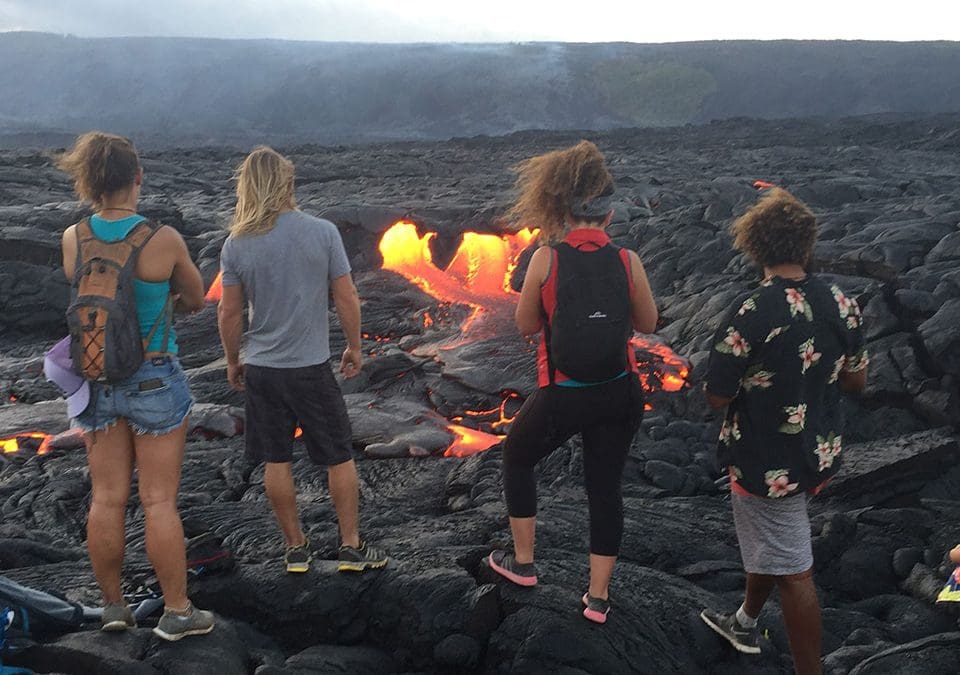Hawaii Volcanoes National Park beckons adventurers with its breathtaking landscapes and dynamic geological wonders. This remarkable destination showcases the raw power of nature, inviting visitors to witness the awe-inspiring forces that shape our planet. From the fiery depths of Kilauea to the towering heights of Mauna Loa, the park offers an unparalleled opportunity to explore active volcanoes and their ever-changing environments.
Travelers venturing into this volcanic wonderland will find themselves immersed in a world of otherworldly beauty and thrilling experiences. The park boasts an array of must-do activities, from hiking through lunar-like landscapes on the Devastation Trail to marveling at the ethereal beauty of steam vents and sulfur banks. Visitors can also embark on an epic journey to the Mauna Loa summit or witness a mesmerizing sunset at the Holei Sea Arch. With so much to see and do, Hawaii Volcanoes National Park promises an unforgettable adventure for nature enthusiasts and thrill-seekers alike.
Discover the Kilauea Visitor Center

The Kilauea Visitor Center, situated at the summit of Kilauea, serves as the perfect starting point for an exciting adventure in Hawaii Volcanoes National Park. This hub of information and discovery offers visitors a wealth of knowledge about the park’s volcanic landscapes and ecosystems.
Kilauea Visitor Center exhibits
Visitors can explore interactive displays and educational exhibits that bring the park’s natural wonders to life. The center showcases the formation and geology of Kilauea volcano, including its eruption history and the various volcanic features found throughout the park. Displays also highlight the diverse plant and animal life, with a focus on endemic and endangered species. For those interested in cultural heritage, exhibits delve into the significance of the Kilauea region to Native Hawaiian people.
Kilauea Visitor Center information
Open daily from 9:00 am to 5:00 pm, the visitor center is staffed by knowledgeable rangers and volunteers ready to assist with the latest information on current conditions, hiking trails, and things to do. A well-stocked bookstore and gift shop offer maps, guides, and souvenirs. Visitors can also borrow wheelchairs free of charge.
Kilauea Visitor Center programs
The center hosts a variety of engaging programs, including ranger-led activities, guided walks, and evening talks. These programs provide deeper insights into the park’s natural and cultural history. After sunset, the auditorium comes alive with special presentations by leading scientists, artists, and cultural experts. Visitors can also enjoy the heavenly voices of Hawaiian music performances, adding a touch of local culture to their experience.
Explore the Devastation Trail

The Devastation Trail offers visitors an exciting journey through a landscape shaped by volcanic forces. This paved path, located off Chain of Craters Road in Hawaii Volcanoes National Park, allows adventurers to witness the raw power of nature and the resilience of life.
Devastation Trail history
Before 1959, the area was covered by a dense rainforest. However, the violent eruption of Kilauea Iki crater that year transformed the landscape dramatically. The eruption, which ended on December 20, 1959, left the area devastated, creating a stark contrast to its former lush state.
Devastation Trail landscape
Today, the trail showcases a recovering ecosystem. Visitors can observe how flora rapidly reclaims the lava-covered terrain. The path is strewn with cinders from the eruption, and keen-eyed explorers can spot fascinating lava features such as Pele’s tears and Pele’s hair—glass-like droplets and threadlike lava formations named after the Hawaiian goddess of volcanoes.
The trail offers breathtaking views of Pu’u Pua’i, a cinder cone formed during the eruption. While hiking Pu’u Pua’i itself is prohibited, the overlook provides a stunning vantage point of Kilauea Iki crater.
Devastation Trail length
This easy hike spans half a mile each way, totaling one mile round trip. The paved trail is wheelchair and stroller accessible, making it an ideal adventure for all visitors. The hike typically takes about an hour to complete, allowing ample time to marvel at the recovering landscape and the enduring power of Hawaii’s volcanoes.
Visit the Steam Vents and Sulfur Banks

Steam Vents explanation
At Wahinekapu (Steaming Bluff), visitors can witness an awe-inspiring natural phenomenon. Hot water vapor billows from cracks in the earth, creating a mesmerizing sight. This striking display occurs as groundwater seeps down to rocks heated by deep underground magma. The intense heat vaporizes the water, sending it back to the surface as steam. The area’s landscape transforms from lush rainforest to grassy fields, as tree roots cannot survive in the intense heat.
Sulfur Banks features
A short distance from the Steam Vents, Ha’akulamanu (Sulfur Banks) offers a unique geological spectacle. Here, volcanic gasses seep out of the ground alongside groundwater steam. These fumes are rich in carbon dioxide, sulfur dioxide, and hydrogen sulfide, creating the distinctive rotten egg smell. The area showcases otherworldly colors, with pure sulfur crystals depositing on the rocks. Some sulfur gasses form sulfuric acid, breaking down lava into clay stained red and brown with iron oxide.
Steam Vents and Sulfur Banks safety
While exploring these fascinating areas, visitors must prioritize safety. It’s crucial to stay on marked trails and avoid venturing off paths, even for photographs. The volcanic ground can be unstable and dangerous. At the Steam Vents, temperatures reach about 145 degrees Fahrenheit. Visitors with heart or respiratory conditions, pregnant women, and young children should avoid the Sulfur Banks due to the potentially harmful gasses. By following these precautions, adventurers can safely experience the raw power of Kilauea’s geothermal wonders.
Hike the Mauna Loa Summit Trail

Mauna Loa Summit Trail difficulty
The Mauna Loa Summit Trail presents an extraordinary challenge for adventurous hikers. This grueling 12-mile trek gains over 4,000 feet in elevation, leading to the summit of one of the world’s largest active volcanoes. The trail traverses rugged terrain, with hikers navigating over jagged and loose lava rock. Marked by cairns, the path can be easily lost in low visibility conditions.
Mauna Loa Summit Trail views
Despite its challenges, the hike offers unparalleled rewards. As trekkers ascend, they’re treated to breathtaking vistas of the surrounding landscape, including other volcanoes on the Big Island. The summit, perched at 13,681 feet above sea level, provides a commanding view of Moku’aweoweo, the mountain’s main caldera. This massive depression spans 2.7 miles long, 1.6 miles wide, and plunges up to 600 feet deep.
Mauna Loa Summit Trail preparation
Proper preparation is crucial for this high-altitude adventure. Hikers should be physically fit and experienced in wilderness trekking. Essential gear includes plenty of water, high-energy snacks, and warm clothing to combat the freezing temperatures at the summit. It’s vital to acclimatize to the elevation changes and be aware of the risks of altitude sickness. Permits are required for overnight stays, and hikers must check current trail conditions and regulations with the National Park Service before embarking on this epic journey.
Witness Sunset at Holei Sea Arch

Holei Sea Arch formation
The Holei Sea Arch, a stunning 90-foot-high natural rock formation, stands as a testament to the raw power of nature. Carved by the relentless pounding of Pacific waves, this arch is part of a dynamic coastline sculpted over centuries. The process begins with sea caves, gradually eroding into arches, and eventually collapsing into sea stacks. This ever-changing landscape showcases the island’s geological evolution, with the Holei Sea Arch being a temporary yet awe-inspiring feature.
Holei Sea Arch viewing tips
To witness this natural wonder, adventurers can embark on a short, quarter-mile hike from the parking lot at the end of Chain of Craters Road. The trail, while mostly flat, traverses uneven lava rock, so sturdy footwear is essential. For the best experience, visitors should aim to arrive during the golden hour before sunset. The arch’s location, about 1,000 feet past the gate, offers a perfect vantage point to witness the day’s end in a truly spectacular setting.
Holei Sea Arch photography
Photographers will find the Holei Sea Arch an irresistible subject, especially during sunset. To capture its full grandeur, a wide-angle lens is recommended. The dramatic lighting conditions during the golden hour provide an opportunity to create stunning images. However, photographers should exercise caution on the uneven terrain and be mindful of the powerful waves. The arch’s ephemeral nature adds urgency to documenting this remarkable feature of Hawaii Volcanoes National Park’s ever-changing coastline.
Where To Stay
Looking for affordable hotels near Volcanoes National Park Hawaii? Kilauea Hospitality offers a variety of surprisingly inexpensive lodging options. We’re nestled in an amazing spot – a true tropical rainforest. It’s absolutely beautiful. We’re near the town of Volcano Village, and only 3 miles from the spectacular Volcanoes National Park. Our rainforest location is perfect for exploring the Big Island.
Conclusion
Hawaii Volcanoes National Park offers a remarkable journey through some of nature’s most awe-inspiring wonders. From the fiery depths of Kilauea to the towering heights of Mauna Loa, visitors can explore active volcanoes and witness the raw power that shapes our planet. The park’s diverse activities cater to all types of adventurers, allowing them to delve into lunar-like landscapes, marvel at ethereal steam vents, and capture breathtaking sunsets at the Holei Sea Arch.
A trip to this volcanic wonderland promises unforgettable experiences and a deeper understanding of Earth’s geological forces. Whether hiking challenging trails, learning at the visitor center, or simply soaking in the otherworldly beauty, Hawaii Volcanoes National Park leaves a lasting impression on all who venture there. This unique destination showcases the ever-changing nature of our planet, reminding us of the powerful forces at work beneath our feet.
FAQs
1. What are popular activities to do in Hawaii Volcanoes National Park?
Visitors often spend a few hours driving along Crater Rim Drive, which offers several spots to stop and explore the unique lava rock formations and stark landscapes. For those looking for a quieter experience, hiking in the park’s Kahuku Unit is recommended. This area features grassy meadows, cattle ranches, and volcanic craters, all under the vast expanse of the Mauna Loa volcano.
2. What are some recommended ways to experience Hawaii Volcanoes National Park?
You can enjoy the park through various activities:
- Crater Rim Drive Tour: A scenic drive around the summit of Kīlauea.
- Chain of Craters Road Tour: A drive down the slopes of Kīlauea to the sea, offering spectacular views.
- The Kahuku Unit: Explore an area known for its dynamic volcanism, rich Hawaiian traditions, and intriguing ranching history.
3. How much time should you allocate to visit Hawaii Volcanoes National Park?
It is advisable to spend at least one full day to adequately explore the highlights of the park, though two days would allow for a more thorough visit. Park staff suggest arriving at sunrise to take advantage of the less crowded trails first, as the park is open 24 hours a day.
4. What is Hawaii Volcanoes National Park most famous for?
The park is renowned for encompassing the summits of two of the world’s most active volcanoes, Kīlauea and Mauna Loa. It stretches from sea level up to 13,680 feet and is recognized both as an International Biosphere Reserve and a UNESCO World Heritage Site, celebrated for its origins in both fire and the sea.

